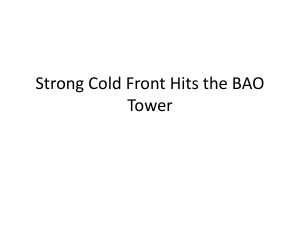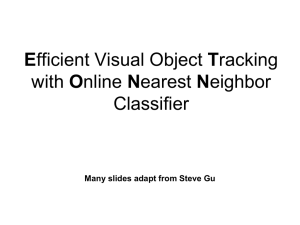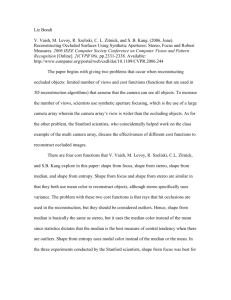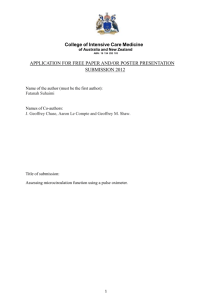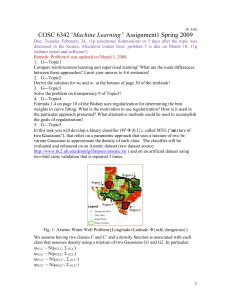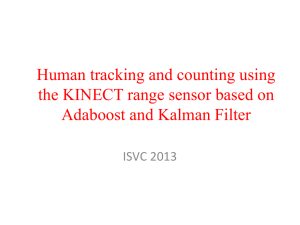Part-based Multiple-Person Tracking with Partial
advertisement
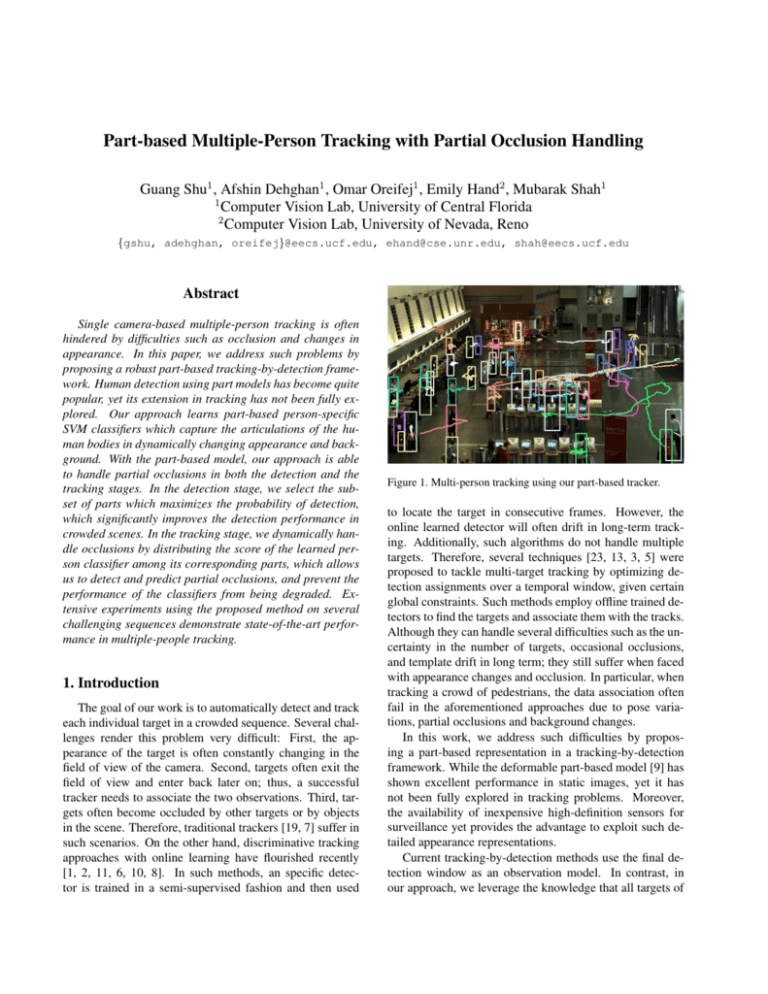
Part-based Multiple-Person Tracking with Partial Occlusion Handling
Guang Shu1 , Afshin Dehghan1 , Omar Oreifej1 , Emily Hand2 , Mubarak Shah1
1
Computer Vision Lab, University of Central Florida
2
Computer Vision Lab, University of Nevada, Reno
{gshu, adehghan, oreifej}@eecs.ucf.edu, ehand@cse.unr.edu, shah@eecs.ucf.edu
Abstract
Single camera-based multiple-person tracking is often
hindered by difficulties such as occlusion and changes in
appearance. In this paper, we address such problems by
proposing a robust part-based tracking-by-detection framework. Human detection using part models has become quite
popular, yet its extension in tracking has not been fully explored. Our approach learns part-based person-specific
SVM classifiers which capture the articulations of the human bodies in dynamically changing appearance and background. With the part-based model, our approach is able
to handle partial occlusions in both the detection and the
tracking stages. In the detection stage, we select the subset of parts which maximizes the probability of detection,
which significantly improves the detection performance in
crowded scenes. In the tracking stage, we dynamically handle occlusions by distributing the score of the learned person classifier among its corresponding parts, which allows
us to detect and predict partial occlusions, and prevent the
performance of the classifiers from being degraded. Extensive experiments using the proposed method on several
challenging sequences demonstrate state-of-the-art performance in multiple-people tracking.
1. Introduction
The goal of our work is to automatically detect and track
each individual target in a crowded sequence. Several challenges render this problem very difficult: First, the appearance of the target is often constantly changing in the
field of view of the camera. Second, targets often exit the
field of view and enter back later on; thus, a successful
tracker needs to associate the two observations. Third, targets often become occluded by other targets or by objects
in the scene. Therefore, traditional trackers [19, 7] suffer in
such scenarios. On the other hand, discriminative tracking
approaches with online learning have flourished recently
[1, 2, 11, 6, 10, 8]. In such methods, an specific detector is trained in a semi-supervised fashion and then used
Figure 1. Multi-person tracking using our part-based tracker.
to locate the target in consecutive frames. However, the
online learned detector will often drift in long-term tracking. Additionally, such algorithms do not handle multiple
targets. Therefore, several techniques [23, 13, 3, 5] were
proposed to tackle multi-target tracking by optimizing detection assignments over a temporal window, given certain
global constraints. Such methods employ offline trained detectors to find the targets and associate them with the tracks.
Although they can handle several difficulties such as the uncertainty in the number of targets, occasional occlusions,
and template drift in long term; they still suffer when faced
with appearance changes and occlusion. In particular, when
tracking a crowd of pedestrians, the data association often
fail in the aforementioned approaches due to pose variations, partial occlusions and background changes.
In this work, we address such difficulties by proposing a part-based representation in a tracking-by-detection
framework. While the deformable part-based model [9] has
shown excellent performance in static images, yet it has
not been fully explored in tracking problems. Moreover,
the availability of inexpensive high-definition sensors for
surveillance yet provides the advantage to exploit such detailed appearance representations.
Current tracking-by-detection methods use the final detection window as an observation model. In contrast, in
our approach, we leverage the knowledge that all targets of
1 2
1
Data Association
Occlusion Handling
Compute
Association
Costs
Occlusion
Reasoning
Human
Detection
Solve Greedy
Bipartite
Graph
Adaptively
Update
Classifier
Person
Classification
Update
Trajectory
State
Occlusion
Prediction
64
2
4
6
8
5
5
3 9
Input Video
7
8 7
3
9
Figure 2. The part-based representation allows detailed correspondence between the articulated human bodies. The figure demonstrates how the parts of two instances of a human can be wellcorresponded even with significant pose changes. Additionally,
the background components in the detection boxes are automatically excluded from the correspondence.
one class (humans in this context) have similar part structure; thus, we employ the sets of detected parts as observation models. Therefore, our method provides several advantages: First, the combination of parts provides a rich
description of the articulated body; thus, it represents the
human better than a single detection window. In particular, since the spatial relations of the parts in an articulated body are often flexible, corresponding targets using
a holistic model (one detection box) is error-prone and may
compare dissimilar parts of the body. In contrast, a partbased representation allows parts to be strictly compared to
their corresponding parts. An example is shown in figure
2, where the parts of two instances of a person are wellcorresponded even with different poses and backgrounds.
Second, the part-based model excludes most of the background within the detection window and thus avoids the
confusion from background changes. Finally, since the partbased detector is offline trained by latent SVM using a large
amount of training samples, it captures significant amount
of discriminative information, which is essential for tracking.
Our tracking framework consists of the steps illustrated
in figure 3. First, we use an extended part-based human
detector on every frame and extract the part features from
all detections. Person-specific SVM classifiers are trained
using the detections, and consequently used to classify the
new detections. We use a greedy bipartite algorithm to associate the detections with the trajectories where the association is evaluated using three affinity terms: position, size,
and the score of the person-specific classifier. Additionally,
during tracking, we reason about the partial occlusion of
a person using a dynamic occlusion model. In particular,
partial occlusions are learned by examining the contribution of each individual part through a linear SVM. This inferred occlusion information is used in two ways: First, the
classifier is adaptively updated with only the non-occluded
Figure 3. The various steps of our approach.
parts, which prevents from being degraded along the occlusion period. Second, the discovered occlusion information
is passed to the next frame in order to penalize the contribution of the occluded parts when applying the person classifier.
In summary, this paper makes the following contributions: First, we adopt the part-based model in multi-target
tracking to tackle occlusion and appearance change problems. Second, we extend the human detection approach in
[9] which allows us to improve the detection in crowded
scenes. Third, we propose a dynamic occlusion handling
method to learn and predict partial occlusions, and thus improve the tracking performance.
2. Related Work
A significant amount of work has been reported for
multi-target tracking-by-detection algorithms. In [23],
Zhang et al. resolve the association between the detection
and the tracking by optimizing a cost-flow network with a
non-overlap constraint on trajectories. Brendel et al. [5] apply a maximum-weight independent set algorithm to merge
small tracklets into long tracks. In that, information from
future frames are employed to locate the targets in the current frame with a temporal delay. In contrast, we employ a
greedy scheme in data association, which is more suitable
for online tracking applications. On the other hand, several
methods such as [15, 22, 14] employ social force models
which consider the interactions between the individuals in
order to improve the motion model. Such methods require
prior knowledge of the 3D scene layout, which, however, is
often unavailable in practical scenarios. Moreover, Benfold
et al. [3] use MCMCDA to correspond the detections obtained by a HOG-based head detector in crowded scenes.
Although they demonstrate promising results, using only
the head is often not discriminative in various tasks.
The method proposed by Breitenstein et al. [4] is evidently the most similar to ours. In that, they propose a
particle-based framework in which detections and interme-
diate detections’ confidences are used to propagate the particles. Additionally, they employ a target-specific classifier
to associate the detections with the trackers. Our method
is different than [4] in that we employ a part-based model
which is more robust and can handle partial occlusions. On
the other hand, Wu et al. [21] train an edgelet-based part detector to track multiple persons by matching the parts using
color features. Such method is, however, not as discriminative as our proposed online-learned classifiers which employ multiple features for reliable data association.
3. Human Detection with Occlusion Handling
We employ a deformable part-based model for human
detection similar to [9]. However, such detector suffers
when the human is occluded. In particular, the final score in
[9] is computed from all the parts, without considering that
some parts can often be occluded. Let H be the HOG feature of the image, and p = (x, y) denotes a part specified
by its position. The detection score at location (xo , yo ) is
computed in [9] as
score(xo , yo ) = b +
i=n
X
s(pi ),
(1)
i=1
where b is a bias term, n is the number of parts, and s(pi ) is
the score of part i which is computed as
s(pi ) = Fpi · φ(H, pi ) − dpi · φd (dx , dy ),
(2)
Figure 4. Left: Human detection results using [9]. Right: Human detection results using our approach where red boxes show
the humans detected as full bodies, green boxes show the humans
detected as upper bodies, and yellow boxes show the humans detected as heads only. It is clear that [9] failed to detect occluded
humans since it does not have an explicit occlusion model, while
our approach detects the occluded parts and excludes them from
the total detection scores, thus achieving significant improvements
especially in crowded scenes.
imizes the detection score
score(xo , yo )
where Fpi is the part filter, and φ(H, pi ) denotes the vector obtained by concatenating the feature vectors from H at
the subwindow of the part pi . (dx , dy ) is the displacement
of the part with respect to its anchor position, φd (dx , dy ) =
(dx , dy , d2x , d2y ) represents the deformation features, and dpi
specifies the coefficients of the deformation features. Under this formulation, it is clear that even if the part was
occluded, its corresponding score still contributes in the final detection score. This is a significant drawback especially when dealing with crowded sequences as shown in
figure 4. In the figure, some humans appear fully in the image; however, several humans appear as only upper parts,
or even only heads. Such impediment in [9] led previous
works such as [3] and [18] to rely on only head detection
and ignore the rest of the body. To address this problem, we
propose to infer occlusion information from the scores of
the parts and consequently utilize only the parts with high
confidence in their emergence. Instead of aggregating the
scores from the set of all the parts P = {p0 . . . pn }, we
select the subset of parts S = {pk . . . pl } ⊆ P , which max-
= b + arg max
Sm
X
i∈Sm
1
×
|Sm |
(3)
1
,
1 + exp(A(pi ) · s(pi ) + B(pi ))
where |Sm | is the set cardinality, and the sigmoid function is
introduced to normalize the scores of the parts. The parameters A and B are learned by the sigmoid fitting approach
in [16]. Note that equation 3 corresponds to the average
score of the parts in the subset. Since the average is sensitive to outliers, it is useful in capturing miss-detected parts.
In other words, a subset Sm which contains occluded parts
is likely to have less average score than a subset without
occluded parts. Therefore, by maximizing equation 3 we
obtain the most reliable set of parts and its corresponding
probability of detection, which we use as the final detection score. We consider only three possible subsets of parts,
namely, head only, upper body parts, and all body parts. We
found such subsets representative enough for most realistic scenarios. Therefore, we do not need to search over all
possible 2n part combinations; instead, solving equation 3
involves only three evaluations which is a negligible overhead to the standard approach. Figure 4 demonstrates the
advantage of our human detector over [9] in detecting occluded humans.
4. Tracking with Occlusion Handling
the size, the velocity, based on the new detection. However, when there is no detection associated due to occlusion
or miss-detection, we use a correlation-based Kalman filter to track the head part of the target in the local area. This
heuristic is particularly useful in crowded scenes where only
humans’ heads are observed.
4.1. Person Classification
4.3. Dynamic Occlusion Handling
We train an online person-specific classifier for each individual target. In each frame, the human detections are
classified by the person classifiers. Relevant previous work
mostly used Adaboost classifier with Haar-like features; in
contrast, our approach leverages the detected human parts
and train a SVM classifier. We extract features from each
individual part, and then concatenate them in a fixed order
as a feature vector. We choose color histogram and Local
Binary Pattern as features because they are highly discriminative for individuals and are complementary to the HOG
feature which is used in the human detector.
The classifier is trained using the detections included
in each trajectory. In particular, the positive examples are
taken from all detections in the trajectory and the negative
examples are taken from the detections of the other trajectories augmented with random patches collected from the
surrounding background in order to improve the classifier’s
discrimination to the background.
4.2. Data Association
Many tracking applications require online forward tracking, i.e. the current trajectories should depend only on previous frames, not on future observations. To meet such requirements, we use a first-order Markov model in data association, in which trajectories are continuously growing as
the tracking proceeds. In every frame, the detections are associated with existing trajectories by a greedy bipartite assignment algorithm [17] which has also been used in [4, 21].
In particular, for each frame, we construct an affinity matrix
M for the trajectories and the detections. Consequently, the
pair with the maximum affinity Mi,j is selected as a match,
and the i-th row and the j-th column are deleted from M .
This procedure is repeated until no more pairs are available.
To evaluate the affinity of a trajectory i and a detection
j, we use
M (i, j) = C(i, j) · E(i, j) · Z(i, j)
(4)
where three terms C is the output of the person-specific
classifier, E and Z are affinities of position and size respectively. We calculate E and Z using similar methods to [21].
The detections which are not associated with any existing trajectories are used to initialize a new potential trajectory. Once the length of a potential trajectory becomes
larger than a threshold, it gets formally initialized. On the
other hand, when a new detection is associated to a trajectory, we update all its state variables, namely, the position,
If a partially occluded person is detected and associated
to a trajectory, the classifier will be updated with noise and
its performance will gradually degrade. Therefore, we employ an occlusion reasoning method to handle this problem. It was shown in [20] that in a detection window, occluded blocks respond to the linear SVM classifier with negative inner products. We adopt this approach to infer which
parts are occluded for those detections with low classifier
score. Assume that the detection’s feature vector x consists of n sub-vectors corresponding to n parts, written as
x = (s1 , . . . , sn ). The decision function for linear SVM
classifier is
f (x) = β +
l
X
αk hx, xk i = β + xT w,
(5)
k=1
where xk is a support vector and w is the weighted sum of
all support vectors. We can divide w to n sub-vectorsP
w=
(w1 , . . . , wn ), and find a set of {βi } such that β =
βi ,
then the separate contribution of each part is represented by
f (si ) = βi + si T wi .
(6)
Each time we re-train a person-classifier, we calculate βi
similar to [20] using the previously observed training samples. Consequently, we obtain the score for each individual
part of x. The part with a negative score is mostly likely to
be occluded. Therefore, we adaptively update the classifier
by only extracting features from the parts with high confidence which are likely to correspond to the non-occluded
parts, while the features for the occluded parts are obtained
from the feature vectors of the previous frames. Using this
technique, the occluded parts will not be included in updating the classifier. Figure 5 demonstrates how occluded parts
have negative responses to the SVM.
On the other hand, the occlusions are highly correlated
in the adjacent frames of videos. Hence, when a partially
occluded part is detected in one frame, it will have a high
probability of being occluded in the consecutive frames. We
harness such smoothness in occlusion to improve the classification performance by introducing an occlusion prediction
method into the data association in order to improve the accuracy. First, we map the part SVM scores into positive
values by
G(si ) = exp(
f (si )
),
δ
(7)
Table 1. Tracking results on The Town Center Dataset.
0.12
0.14
0.11
0.12
0.16
−0.10
−0.09
0.09 0.10
0.11
0.09
0.31
0.07
0.01
0.10
−0.03
Figure 5. Left: a certain target human is detected, non of his
parts are occluded (shown in blue); thus, all parts have positive
responses. Right: the same target is observed again in another
frame; however, three of his parts are occluded by another person (occluded parts are shown in red). The occluded parts have
negative responses as shown in the figure. In our framework, the
occluded parts are excluded when updating the person’s model.
Additionally, when performing person classification, the occluded
parts have lower contribution since they are assigned weights relative to their score (refer to equation 8).
where δ is a constant. The occluded parts will likely
have lower values as demonstrated in the example in figure 5. Therefore, when performing person classification,
we weight each part by the non-occlusion confidence G(si )
and normalize the total score
n
P
n
G(si )(βi + sTi wi )
i=1
C=
.
(8)
n
P
G(si )
i=1
In the following frames, we examine the occlusion again
and update the occlusion confidence until the classifier
score is larger than a threshold. This allows the occlusion information to be passed across continuous frames, and
the person classifier to have higher weight corresponding to
non-occluded parts.
5. Experimental Results
We extensively experimented on the proposed method
using Oxford Town Center dataset [3], and two new datasets
that we collected; the Parking Lot dataset, and the Airport
dataset. The experimental datasets provide a wide range of
significant challenges including occlusion, crowded scenes,
and cluttered background. In all the sequences, we only
use the visual information and do not use any scene knowledge such as the camera calibration or the static obstacles. It
is important to notice that we selected the aforementioned
datasets since they include high quality imagery which is
more suitable to our approach since the part-based model
requires detailed body information.
In our implementation, we use the pre-trained pedestrian
model with 8 parts from [9]. The feature vector for each
Benfold et al. [3]
Zhang et al. [23]
Pellegrini et al. [15]
Yamaguchi et al. [22]
Leal-Taixe et al. [14]
Ours/detection from [9]
Ours/our detection
TP
80.4
71.5
70.7
70.9
71.5
71.1
71.3
TA
64.8
65.7
63.4
63.3
67.3
72.2
72.9
DP
80.5
71.5
70.8
71.1
71.6
71.2
71.4
DA
64.9
66.1
64.1
64.0
67.6
72.7
73.5
part consists of 125-bin RGB color histogram using 5 bins
for each channel and 59-bin LBP histogram. We apply normalization for each part and concatenate all 8 parts into one
feature vector of 1472 dimensions. The training data for
each person-specific classifier consists of up to 100 positive samples and 100 negative samples. When the number
of collected samples exceeds this limit, we delete the oldest ones to ensure the model is up to date. Aside from the
human detection, our tracker runs at 1 to 5 fps on a conventional desktop, depending on the number of humans in the
sequence. Figure 6 shows example frames from the experiments’ sequences with the tracking results overlaid. Additionally, figure 7 shows example results of our dynamic
occlusion handling.
We evaluate our tracking results using the standard
CLEAR MOT metrics [12], TP (tracking precision), TA
(tracking accuracy), DP (detection precision) and DA (detection accuracy). Note that TP only measures the precision
of tracked object positions, but TA measures false negatives,
false positives, and ID-switches. Therefore TA has been
widely accepted as the main gauge of performance of the
tracking methods.
Town Center Dataset: The frame resolution in this
dataset is 1920 × 1080, and the frame rate of 25 fps. This
is a semi-crowded sequence with rare long-term occlusions.
The motion of pedestrians is often linear and predictable.
In table 1, we compare results with [3, 23, 15, 22, 14] using the results reported in [14]. With the same experimental
settings, our method significantly outperforms all previous
methods in TA. The improvement in our method is a result of two main factors: First, the part-based model could
better represent the articulated body and thus improves the
accuracy in data association. Second, our dynamic occlusion handling module allows us to robustly track partially
occluded humans.
Parking Lot Dataset: The frame resolution in this
dataset is 1920 × 1080, and the frame rate of 29 fps. This
is a modestly crowded scene including groups of pedestrians walking in queues. The challenges in this dataset
include long-term inter-objects occlusions, camera jittering, and similarity of appearance among the humans in the
scene. The tracking results for the Parking Lot dataset are
summarized in table 2.
Figure 6. Example tracking results using our method. Top row shows the Town Center sequence, middle row shows the Parking Lot
sequence, and the bottom row shows the Airport sequence.
Figure 7. Examples results of our dynamic occlusion handling approach. Top row shows the original image, and bottom row shows the
detected humans are their corresponding parts, where the occluded parts shown in red.
Table 2. Tracking results on the Parking Lot dataset.
Ours/detection from [9]
Ours/our detection
TP
73.7
74.1
TA
77.1
79.3
DP
73.8
74.2
DA
77.5
79.8
Airport Dataset: The frame resolution in this dataset is
4000 × 2672, and the frame rate of 5 fps. This is a very
challenging real world scene with severe occlusions resulting from both static obstacles in the scene and inter-person
occlusions. Additionally, the humans’ appearance and pose
significantly change along the sequence because of the wide
field of view of the camera and the low frame rate. However,
our approach still achieved promising results on this dataset.
The tracking results for the airport dataset are shown in table
3. Note that TA is significantly higher using our detection
than using [9] on this dataset since it is more crowded, and
thus occlusions occur very frequently.
Finally, we analyzed the performance of our approach
Table 3. Tracking results on the Airport Sequence.
Ours/detection from [9]
Ours/our detection
TP
66.1
67.2
TA
27.2
52.2
DP
66.3
67.4
DA
28.4
53.6
85#
80#
Color+LBP#
75#
All#
MOTA%
70#
Color+HOG#
65#
60#
Color#
55#
Color#4#bins#
50#
LBP#
45#
HOG#
40#
Color#3#Bins#
35#
Town 1#Center 2# Lot Parking 3#
Airport Figure 8. The performance of our tracking approach using different feature combinations.
using different feature combinations. Figure 8 demonstrates
the obtained results. Color and LBP are evidently the most
distinguishing features for all datasets.
6. Conclusion
We proposed an effective multiple-person tracking
method using part-based model and occlusion handling.
Our method captures rich information about individuals;
thus, it is highly discriminative and robust against appearance changes and occlusions. We employ an extended
part-based human detector to obtain human part detections.
Consequently, distinguishing person-specific classifiers are
trained using the parts’ features and then employed to associate the detections with the tracking. We handle partial
occlusions through dynamic occlusion reasoning and prediction across frames. We demonstrated by experiments
that our tracking method outperforms state-of-the art approaches in crowded scenes.
Acknowledgment
This research is supported by the Pacific Northwest National Laboratory (PNNL) in Richland, Washington. We
also thank Vladimir Reilly, Imran Saleemi and Hamid Izadinia for the exchange of ideas that helped improve this article.
References
[1] S. Avidan. Ensemble tracking. In PAMI, 2010.
[2] B. Babenko, M. Yang, and M. Hsuan. Visual tracking with
online multiple instance learning. In PAMI, 2010.
[3] B. Benfold and I. Reid. Stable multi-target tracking in realtime surveillance video. In CVPR, 2011.
[4] M. Breitenstein, F. Reichlin, B. Leibe, E. Koller-Meier, and
L. V. Gool. Robust tracking-by-detection using a detector
confidence particle filter. In ICCV, 2009.
[5] W. Brendel, M. Amer, and S. Todorovic. Multiobject tracking as maximum weight independent set. In CVPR, 2011.
[6] R. Collins and Y. Liu. Online selection of discriminative
tracking features. In ICCV, 2003.
[7] D. Comaniciu, V. Ramesh, and P. Meer. Kernel-based object
tracking. In PAMI, 2003.
[8] T. B. Dinh, N. Vo, and G. Medioni. Context tracker: Exploring supporters and distracters in unconstrained environments. In CVPR, 2011.
[9] P. Felzenszwalb, R. Girshick, D. McAllester, and D. Ramanan. Object detection with discriminatively trained part
based models. In PAMI, 2010.
[10] H. Grabner, M. Grabner, and H. Bischof. Real-time tracking
via on-line boosting. In BMVC, 2006.
[11] Z. Kalal. P-n learning?: Bootstrapping binary classifiers by
structural constraints. In ICCV, 2010.
[12] R. Kasturi, D. Goldgof, P. Soundararajan, V. Manohar,
J. Garofolo, M. Boonstra, V. Korzhova, and J. Zhang. Framework for performance evaluation for face, text and vehicle
detection and tracking in video: data, metrics, and protocol.
In PAMI, 2009.
[13] C. Kuo, C. Huang, and R. Nevatia. Multi-target tracking by
on-line learned discriminative appearance models. In CVPR,
2010.
[14] L. Leal-Taixe, G. Pons-Moll, and B. Rosenhahn. Everybody
needs somebody: Modeling social and grouping behavior
on a linear programming multiple people tracker. In ICCV
Workshop on Modeling, Simulation and Visual Analysis of
Large Crowds, 2011.
[15] S. Pellegrini, A. Ess, , and L. van Gool. Improving data
association by joint modeling of pedestrian trajectories and
groupings. In ECCV, 2010.
[16] J. C. Platt. Probabilistic outputs for support vector machines
and comparisons to regularized likelihood methods. In Advances in Large Margin Classifiers. MIT Press, 1999.
[17] K. Rangarajan and M. Shah. Establishing motion correspondence. In Graphics and Image Processing: Image Understanding, 1991.
[18] M. Rodriguez, I. Laptev, J. Sivic, and J.-Y. Audibert.
Density-aware person detection and tracking in crowds. In
ICCV, 2011.
[19] J. Shi and C. Tomasi. Good features to track. In CVPR, 1994.
[20] X. Wang and T. Han. An hog-lbp human detector with partial
occlusion handling. In ICCV, 2009.
[21] B. Wu and R. Nevatia. Detection and tracking of multiple, partially occluded humans by bayesian combination of
edgelet based part detectors. In International Journal of
Computer Vision, 2007.
[22] K. Yamaguchi, A. Berg, L. Ortiz, and T. Berg. Who are you
with and where are you going? In CVPR, 2011.
[23] L. Zhang, Y. Li, and R. Nevatia. Global data association for
multi-object tracking using network flows. In CVPR, 2008.
